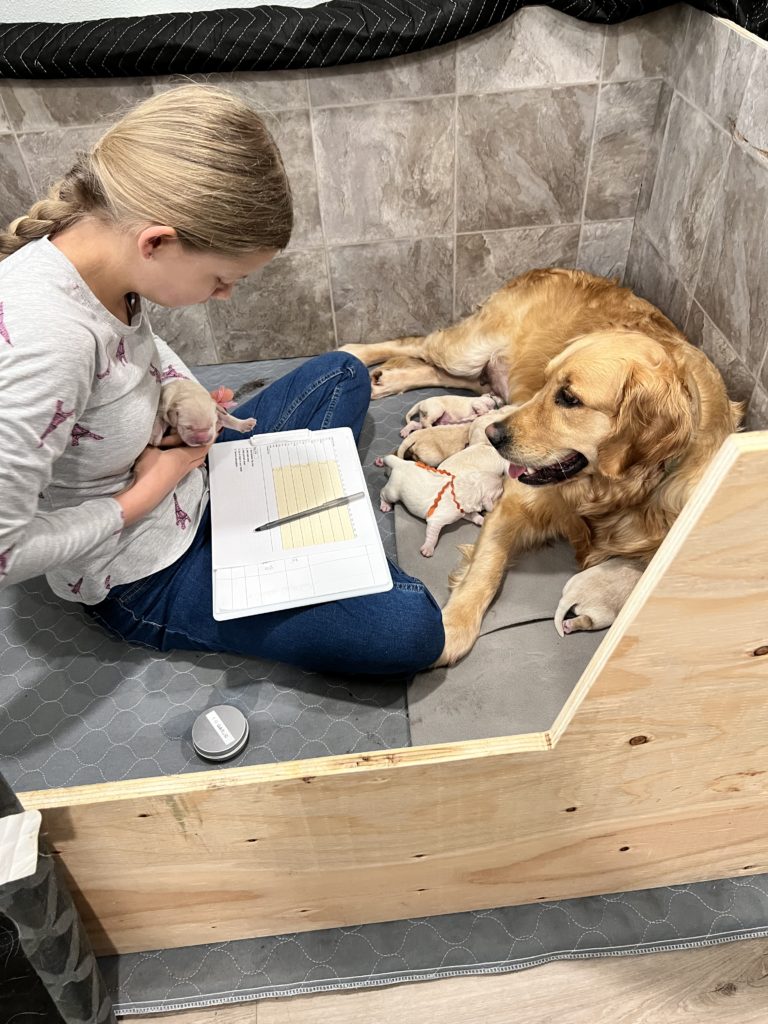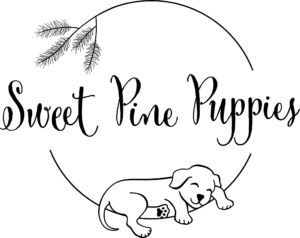What is Sweet Pine Puppy Preschool?
Introducing a new puppy to your home can be an exciting and rewarding experience, but it can also be a challenging one. Proper socialization and training are crucial to ensure that your puppy grows up to be a well-behaved and well-adjusted dog. That’s where our Puppy Preschool Program comes in.

The Sweet Pine Puppy Preschool Program is a comprehensive curriculum, based mainly on the Raising the Empowered Puppy, designed to give puppies the best possible start in life. It includes a range of activities and exercises that help puppies develop the skills they need to thrive in a home environment, including socialization, desensitization, and the beginnings of basic obedience and house training.
When does Puppy Preschool start?
One of the key components of the curriculum is early introduction. Beginning early means the puppy will be introduced to things in a gentle way which will get them used to being handled by humans from the beginning.
Common Puppy Preschool Developmental Programs
ESI (Early Scent Introduction) and ENS (Early Neurological Stimulation) are two types of early developmental programs that are often used to help puppies become well-adjusted and adaptable dogs. Both programs involve introducing puppies to a range of experiences and gentle stimuli from a very young age, starting as early as three days old.
What is ESI (Early Scent Introduction)?
ESI is a program that involves introducing puppies to a variety of different scents, including scents from different animals, people, and environments. The idea behind this is that by introducing puppies to these scents at a young age, they will become more familiar with them and less likely to be fearful or reactive to them later on. This can help puppies to become more adaptable and better able to handle new experiences and environments.
What is ENS (Early Neurological Stimulation)?
ENS on the other hand, is a program that involves a series of specific handling exercises designed to stimulate the puppy’s neurological system. These exercises are designed to mimic the types of stimulation that a puppy would receive from its mother, such as being licked or nuzzled. The idea behind ENS is that by stimulating the puppy’s neurological system in this way, it will help to strengthen the puppy’s immune system, enhance its motor skills, and improve its overall resilience.
Our Puppy Preschool in Action
Puppy Training from Day 3 to 16
Some of the specific exercises used in ENS include holding the puppy in various positions, gently touching its paws and tail, and exposing it to various types of sounds and textures. These exercises are carried out for only a few minutes each day, starting from three days after birth and continuing until the puppy is about 16 days old.
Both ESI and ENS are intended to help puppies become more well-adjusted and adaptable dogs, with improved physical and mental resilience. For our program, we understand the specific needs of young puppies and ensure that they are carried out gently, safely and effectively.
Another important aspect of the Puppy Preschool Program’s curriculum is daily handling. They are handled gently every day of life, and beginning when the puppies are 17 days old they are handled using a 10-step program to introduce husbandry and human handling.
Training and Human Handling
This introduces and gets them used to being touched, for example, on the pads of their paws and nails (where groomers will need to handle as the puppy grows older) and being touched on their gums (for dental cleanings when they get older) as well as laying on their backs and being touched for vet checks. It also gets them used to being pet on their backs, head and ears. This 10-step handling is done daily and the puppy is gradiently and gently gotten used to more and more human interaction.
Puppy Training on Day 17
Puppy Training 3 Weeks Old
Once the puppy is 3 – 4 weeks old, we begin introducing handling by a variety of people, including children, adults, and other animals (our personal in-home animals, under very close supervision), to help them become comfortable with different types of touch and interaction. This can help to reduce anxiety and fearfulness in the long run.
Why We Do Puppy Preschool
Puppy Crate Training
What does crate training look like for puppies? Crate training is also introduced early on in our Puppy Preschool Program. Puppies are gradually introduced to their crate and encouraged to use it as a safe and comfortable space.
Puppy Potty Training
What does potty training look like for puppies? We start potty training at week 3. It starts with putting piddle pads in their play area. This starts off taking up about 3/4 of their space. It is gradually reduced to one square and the puppies go onto the pad to go potty. They are also introduced to a doggy door at 5-6 weeks old and are encouraged to use it for potty breaks instead of the piddle pad. This helps to establish good potty habits from a young age.
Indoor Obedience Training
The Preschool curriculum also includes the beginnings of indoor obedience training. Puppies are taught basic indoor etiquette such as not barking all the time and not chewing on shoes. Of course these will need to be continued at home with your puppy, but these concepts are introduced as much as possible at such a young age. They are also taught to be quiet and sit before being given their food or a toy, which helps to establish a foundation for further training later on.
Giving Puppies the Best Possible Start
Overall, our Puppy Preschool Program’s curriculum is designed to give puppies the best possible start in life. By providing early socialization, daily handling, and early obedience training, puppies are being set up for success in their new homes. With these skills, they are more likely to get along with other pets and children and to adapt easily to new environments.
Visit our YouTube channel to see more of our Puppy Preschool training program in action!
